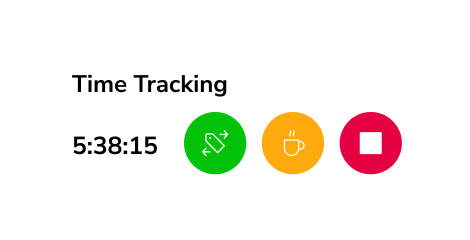-
A flexible software with great customer support
Jibble's great! The software is easy to use - you can pick and choose it's features according to your business needs. Also, the facial recognition feature is really good and very easy. 10/10.
Great for tracking attendance on autopilot
Jibble is fairly easy to use and does the job. I love the integration with other apps, especially Slack, as well as the options for exporting reports.
Jibble has been great!
Jibble is exactly what I was looking for in a time tracking software. The price is great and the customer support is very helpful. They take care of my questions and queries immediately.
Extremely efficient and easy
I love having the Slack integration so my team can quickly and easily Jibble in and out without opening their browser or accessing the site. It is extremely efficient and easy.
Hassle-free work hour tracking!
I am very happy with Jibble because of its functionality and ease-of-use. My employees can record their work hours hassle-free with accurate timesheets. I will definitely recommend Jibble to my friends and colleagues as it is very helpful and easy to use.
Works perfectly!
Jibble is a useful time and attendance management system for construction with the best price. The features are so easy to use, and it works perfectly with on-site or remote work.
Extraordinarily easy time tracking for architects
This is an excellent tool that helps me keep precise record of my working hours. I find it easy to plan my time and resources for different tasks with JIbble.
Jibble makes managing time and billing clients pain and stress free
The slack integration is very useful, and also the reporting makes it easy to see numbers and understand how much to bill clients quickly and easily using my accounting software, Xero. I also think the architecture of the front end of the web app is very clear and intuitive.
FAQs
Some frequently asked questions...
The country with the highest work hours weekly is Bhutan at 54.5 hours per week.
Here are the countries with the highest average weekly hours worked per employee according to the ILO:
- Bhutan – 54.5 hours per week
- Sudan – 50.8 hours per week
- Lesotho – 50.2 hours per week
- Republic of the Congo – 48.7 hours per week
- United Arab Emirates – 48.4 hours per week
- Sao Tome and Principe – 48.2 hours per week
- Jordan – 47.8 hours per week
- Liberia – 47.5 hours per week
- Pakistan – 47.5 hours per week
- Qatar – 46.8 hours per week
In the US, an average of 36.4 hours per week is maintained with employees often adopting 9-5 shifts daily.
It’s tricky to exactly specify the job with the longest working hours as such numbers often differ based on roles and regions.
Common jobs known for long working hours in the US, as previously reported by the Bureau of Labor Statistics, include physicians and surgeons, veterinarians, farm, ranch and agricultural managers, food service managers, and chief executives.
Such jobs recorded the highest percentages of workers working 60 hours a week or more.
Other notable mentions are fire fighters, clergy, rail roads, conductors and yardmasters, lawyers, and general and operations managers.
The country with the lowest work hours weekly is Yemen at 25.9 hours per week.
Here are the countries with the lowest average weekly hours worked per employee according to the ILO:
- Yemen – 25.9 hours per week
- Netherlands – 26.8 hours per week
- Norway – 27.1 hours per week
- Austria – 28.4 hours per week
- Denmark – 28.8 hours per week
- Finland – 28.8 hours per week
- Vanuatu – 29 hours per week
- Mozambique – 29 hours per week
- Sweden – 29.3 hours per week
- Germany – 29.6 hours per week
In the US, an average of 36.4 hours per week is maintained with employees often adopting 9-5 shifts daily.
According to the American Time Use Survey, in 2023, the average working hours for employees working from home was 5.1 hours on their working days, and 7.9 hours for office workers.
In October 2024, Statista found the average working week in the US was 34.3 hours, for all employees on private nonfarm payrolls, including part-timers.
It’s worth noting that the Bureau of Labor Statistics noted differences in the average work week among industries, with employees in the mining and logging industry working 45.5 hours a week, and employees in private education and health services working 33.4 hours a week in April 2023.
A work hour calculator allows users to input hours worked, breaks, and overtime details to automatically compute total pay.
The calculator then generates a summary with respective totals, making payroll processing easier and more accurate.
Jibble helps employees track their work hours with the option to clock in and out with a click of a button.
Tracked hours can be exported into timesheets for insights and payroll purposes.
Other features such as reminders for clock-ins and clock-outs as well as supporting technologies like face recognition and GPS support modern work environments time tracking.
Don't waste another minute! Jibble is FREE forever.
Get jibbling with the ultimate time tracking software...
Track time now - it's FREE!
FREE Work Hour Calculator
The Fair Labor Standards Act (FLSA) sets work hours regulations in the US federally, ensuring that most employees receive minimum wage and overtime pay. As per the FLSA, workers must be paid time-and-a-half for any work hours that surpass 40 hours in a week, with certain salaried employees in specific roles being exempt from this requirement. What law governs work hours in the US?
There is no set limit in US law (the FLSA) on the number of hours that employees (16 and above) can work in a workweek. However, according to the OSHA, a normal work shift is generally eight consecutive hours of work daily, for five days weekly, and a minimum of eight hours of rest. As such, shifts having longer continuous hours, requiring more consecutive work days, or demanding evening work are to be regarded as extended or unusual. Extended shifts can be opted for when resources are scarce and are not penalized by law. What are work hours in the US?
Every hour worked in the US within a 40-hour workweek must be compensated at least the minimum wage—$7 federally. Any work beyond 40 hours in a week counts as overtime and is paid at one and one-half times the employee’s regular rates of pay. How are work hours paid for in the US?
Do breaks count as work hours in the US?
While federally not mandated, in general, short breaks (5-20 minutes), if offered in the US, are considered part of an employee’s work hours and should be compensated for.
Meal breaks, which are typically 30 minutes or longer and are also not legally mandated, if offered, usually don’t count as work hours unless the employee is required to work during the break (for example: secretaries that must pick up phone calls during lunch).
Learn more about: Labor Laws in the US

Photo by TaniaRose on Pixabay
Employers should track the work hours of employees in the US as they are required by the federal FLSA to keep certain records for each worker, including data about the hours worked each day and the total hours worked each workweek. The law requires this information to be accurate. Incorrect hour tracking, especially regarding overtime or breaks, can lead to legal violations, resulting in fines, lawsuits, or damage to the company’s reputation. Should employers calculate work hours in the US?
Actionable tips for employers on how to efficiently track work time:
- Implement a Clear Time Tracking System: Establish a standardized system for tracking work hours, whether through manual logs, time clocks, or software, so employees consistently record their hours.
- Encourage Regular Clock-ins and Clock-outs: Remind employees to clock in and out consistently at the start and end of each shift, as well as for breaks, to ensure accurate work hour records.
- Review Time Entries Regularly: Regularly audit work hour records to identify any discrepancies or inconsistencies and address them promptly to prevent payroll errors.
- Monitor Overtime: Set up a process for reviewing work hours frequently to spot any overtime early, ensuring employees are compensated properly and avoiding labor law violations.
- Track Breaks and Meal Periods: Ensure that break times and meal periods are logged correctly and in compliance with labor laws to avoid confusion about paid vs. unpaid hours.
- Use Time Rounding Wisely: If using manual tracking methods, consider rounding work hours in accordance with company policy to simplify record-keeping, but be transparent with employees.
- Use Time Tracking Tools: Leverage time tracking software or apps to automatically log work hours, reducing human error and ensuring accuracy.

